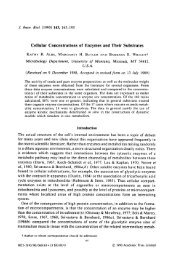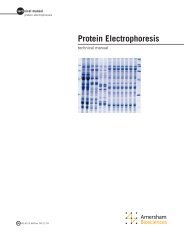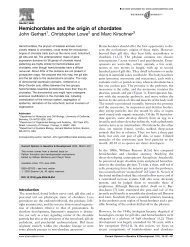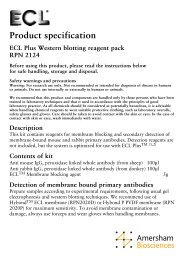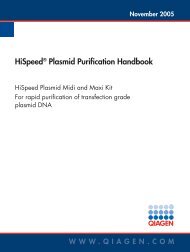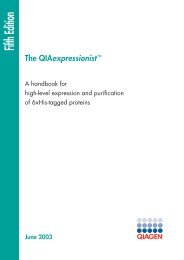Invitrogen Bac to Bac Expression System
Invitrogen Bac to Bac Expression System
Invitrogen Bac to Bac Expression System
You also want an ePaper? Increase the reach of your titles
YUMPU automatically turns print PDFs into web optimized ePapers that Google loves.
The <strong>Bac</strong>-<strong>to</strong>-<strong>Bac</strong> ® <strong>Bac</strong>ulovirus <strong>Expression</strong> <strong>System</strong><br />
Components of<br />
the <strong>Bac</strong>-<strong>to</strong>-<strong>Bac</strong> ®<br />
<strong>Bac</strong>ulovirus<br />
<strong>Expression</strong><br />
<strong>System</strong><br />
The <strong>Bac</strong>-<strong>to</strong>-<strong>Bac</strong> ® <strong>Bac</strong>ulovirus <strong>Expression</strong> <strong>System</strong> facilitates rapid and efficient<br />
generation of recombinant baculoviruses (Ciccarone et al., 1997). Based on a<br />
method developed by Luckow et al., 1993, the <strong>Bac</strong>-<strong>to</strong>-<strong>Bac</strong> ® <strong>Bac</strong>ulovirus <strong>Expression</strong><br />
<strong>System</strong> takes advantage of the site-specific transposition properties of the Tn7<br />
transposon <strong>to</strong> simplify and enhance the process of generating recombinant<br />
bacmid DNA.<br />
• The first major component of the <strong>System</strong> is a pFast<strong>Bac</strong> vec<strong>to</strong>r in<strong>to</strong> which the<br />
gene(s) of interest will be cloned. Depending on the pFast<strong>Bac</strong> vec<strong>to</strong>r selected,<br />
expression of the gene(s) of interest is controlled by the Au<strong>to</strong>grapha californica<br />
multiple nuclear polyhedrosis virus (AcMNPV) polyhedrin (PH) or p10<br />
promoter for high-level expression in insect cells. This expression cassette is<br />
flanked by the left and right arms of Tn7, and also contains a gentamicin<br />
resistance gene and an SV40 polyadenylation signal <strong>to</strong> form a mini Tn7.<br />
• The second major component of the <strong>System</strong> is the DH10<strong>Bac</strong> E. coli strain that<br />
is used as the host for your pFast<strong>Bac</strong> vec<strong>to</strong>r. DH10<strong>Bac</strong> cells contain a<br />
baculovirus shuttle vec<strong>to</strong>r (bacmid) with a mini-attTn7 target site and a helper<br />
plasmid (see the next page for details). Once the pFast<strong>Bac</strong> expression<br />
plasmid is transformed in<strong>to</strong> DH10<strong>Bac</strong> cells, transposition occurs between the<br />
mini-Tn7 element on the pFast<strong>Bac</strong> vec<strong>to</strong>r and the mini-attTn7 target site on<br />
the bacmid <strong>to</strong> generate a recombinant bacmid. This transposition reaction<br />
occurs in the presence of transposition proteins supplied by the helper<br />
plasmid.<br />
Once you have performed the transposition reaction, you will isolate the high<br />
molecular weight recombinant bacmid DNA and transfect the bacmid DNA in<strong>to</strong><br />
insect cells <strong>to</strong> generate a recombinant baculovirus that can be used for preliminary<br />
expression experiments. After the baculoviral s<strong>to</strong>ck is amplified and titered, this<br />
high-titer s<strong>to</strong>ck can be used <strong>to</strong> infect insect cells for large-scale expression of the<br />
recombinant protein of interest.<br />
For a schematic representation of the <strong>Bac</strong>-<strong>to</strong>-<strong>Bac</strong> ® <strong>Bac</strong>ulovirus <strong>Expression</strong> <strong>System</strong>,<br />
see the diagram on page 5.<br />
continued on next page<br />
3



